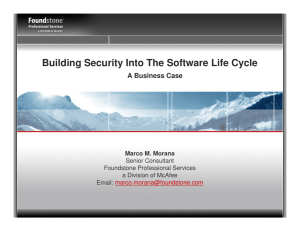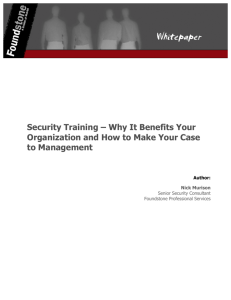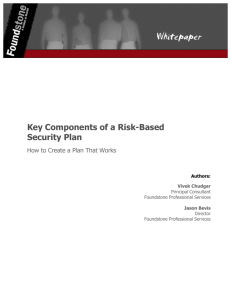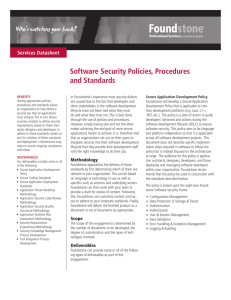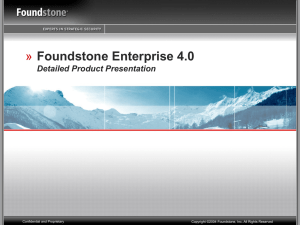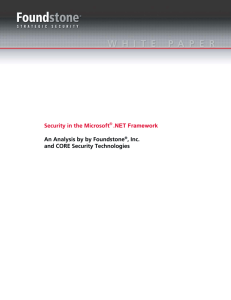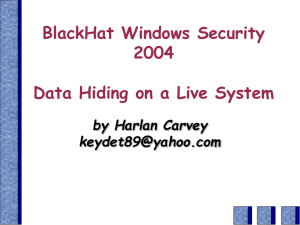Information Security Metrics Using Foundstone’s FoundScore to Assign Metrics and Measure Enterprise Risk
advertisement
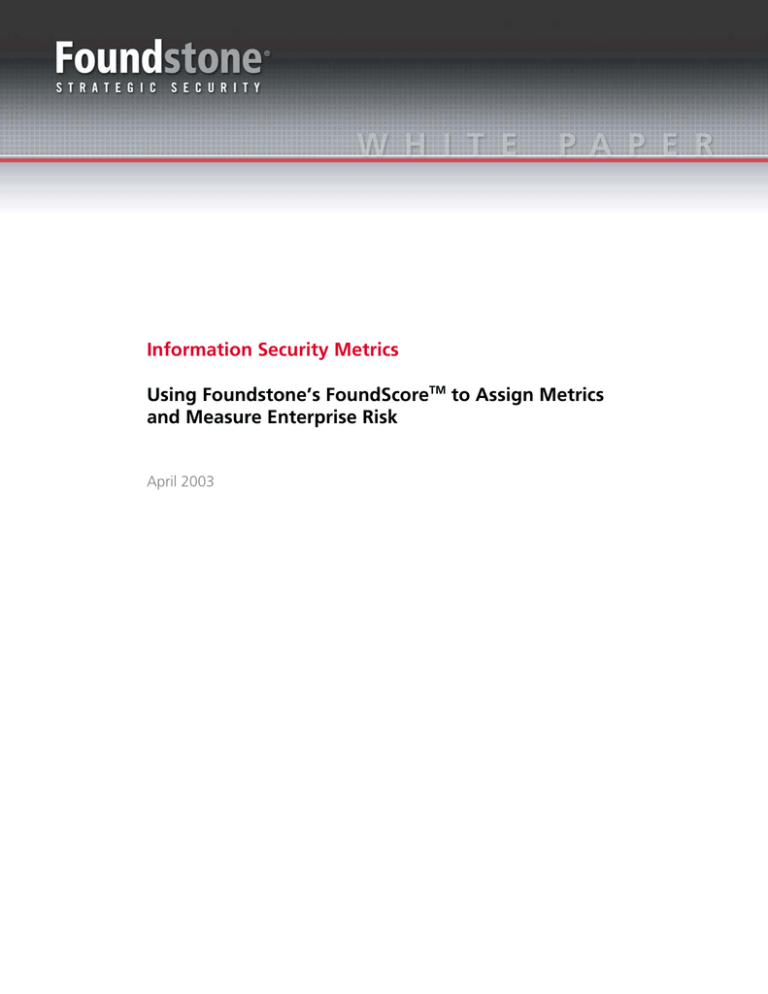
Information Security Metrics Using Foundstone’s FoundScoreTM to Assign Metrics and Measure Enterprise Risk April 2003 Information Security Metrics Using Foundstone’s FoundScore to Assign Metrics and Measure Enterprise Risk Security has always been viewed as a cost center, never typically associated with revenue-driving initiatives. This can make it difficult to get approval for and justify security budgets and expenditures on software, hardware, personnel, services, training, processes and procedures. A well-established approach called Return on Security Investment (ROSI) is often used by security organizations. Introduction The purpose of this whitepaper is to address the use of reliable metrics in measuring the business value of expenditures and actions taken relative to information security, and effectively communicating this information to the highest levels of the organization. This paper discusses why you should use security metrics to understand risk in your environment, how to use FoundScore™ to track security improvements in the environment and what the evolution of risk based management will be in the future. Foundstone helps companies take control of their digital risk and manage it intelligently and proactively. They provide expertise in strategic security that enables clients to create the right balance of technology, people and processes for continuous and measurable digital risk management. Using this asset-focused approach, an enterprise can more effectively deploy human and financial resources to extract the greatest value from its security investments. Measuring risk with FoundScore makes it possible for clients to quantify progress by assigning measurable values to security, allowing them to demonstrate tangible results for security programs, significantly extending “soft” or qualitative measurements. Risk to an organization can be analyzed objectively, based on three factors: > Asset values and counter measures in place to protect those assets > Threats against those assets > Vulnerabilities that take advantage of the threats The FoundScore is a metric that can be used as a guide for spending and resource allocation, to show specific returns on investments and tangible change measures. The metrics can be tracked over time, benchmarking against industry averages. Companies can also compare the scores of their individual offices, to apply the right security measures to areas of greatest risk to achieve significant cost reductions. FoundScores are industry specific, to accommodate different tolerance levels for risk. For example, risk associated with information access might be more important in the financial industry than the healthcare industry, which may be primarily concerned with confidentiality and integrity. Calculations for measuring risk can also differ by sector. Because Foundstone tests a variety of companies, they can create a quantitative list of FoundScores that can be used as a yardstick for each industry. www.foundstone.com © 2003 Foundstone, Inc. All Rights Reserved | 1 Why Use Security Risk Metrics? In tighter economic climates, it can be extremely difficult to justify the cost of new technologies. Implementing security technologies does not translate to direct revenue generation; therefore, other means of analysis must be used to substantiate expenditures. Security metrics help shift from purely qualitative values to significant numerical measurements. A qualitative approach is subjective −“What is my company's reputation worth?”− while a quantitative approach uses hard numerical values to measure security risks and return on investment. The Limitations of a Qualitative Approach In the past, the effectiveness of security spending has used soft measurements −factors such as the size of a security staff relative to that of the annual budget, or by the speed of resolution or “patches” based on new vulnerabilities or viruses. This left a large gap, because it didn’t demonstrate cost savings of preventing digital attacks. The method was reactive, and not quantifiable. For example: Scenario A: An Outdated Approach to Security Assets, Threats, and Vulnerabilities: > Asset − Your company’s Web servers can be reached by the public and potentially attacked. > Threat − A new vulnerability is released that targets Web servers. > Vulnerability − The exploit was immediately released to the public and your Web server is vulnerable. The IT team can only react when something actually occurs. A reaction can be stimulated by the Intrusion Detection System alerting you after an actual break-in to the server. Solution The IT/Security team patches their vulnerable servers as needed. Problems with this solution: > The IT/Security team is not proactive. > Individual patches can be applied to fix vulnerabilities, but the overall security posture of the environment is not addressed. > The value of the Web servers is unknown; too many or too few security resources may be applied to the Web servers because the value cannot be measured in dollars and a risk rating is not applied to the asset. > Changes are made on an ad-hoc basis. > It is difficult to measure the results of changes. Quantitative Risk Approach Yields Results ROSI fills this measurement gap, providing a necessary quantifiable approach. It is the approved method for calculating the value of security investments in total dollars saved. It can be calculated by linking specific security products to numerical measurements of an organization’s security posture. For example, if you purchase a firewall, how will it affect your overall security status? Can you show that you saved a specific dollar amount because you weren’t exploited after the latest Web server vulnerability was discovered, and therefore didn’t lose any downtime or sales? ROSI delivers these answers. www.foundstone.com © 2003 Foundstone, Inc. All Rights Reserved | 2 Using a strategic, risk-based approach, such as that offered by Foundstone, an organization presented with Scenario A will dedicate resources—through constant monitoring and analysis—to high risk areas, which are defined by the importance of the assets. The Web server is the asset, and it may be deemed “high risk” and thus require greater security measures. A practical approach will test the security of the Web servers in advance so that any weaknesses found can be fixed before they are exploited. By knowing up front the level of risk to each of your assets, either by assigning a dollar value or specifying a criticality rating, you can quantify the security measures, and implement the appropriate level of security. Quantitative vs. Qualitative Approach Quantitative Approach: Use of numerical values assigned to assets to measure risk Quantitative Approach to Measuring Risk PROs CONs > Results are based on objective measurements > Calculations can be complex > Monetary value is assigned to risk and security measurements > Significant upfront time and effort is required to assign risk ratings to assets > Comparisons of security posture over time can be calculated > Industry standards for risk and return have not yet been set > Risk management measures can be tracked over time > Resources can be dedicated to high risk areas > Return on investment on security solutions can be measured and tracked > Business impact analysis can be performed > Comparison to industry standards can be performed > Management can understand dollar costs of security based on risk Qualitative Approach: Use of subjective values to assign resources to potential risk Qualitative Approach to Measuring Risk PROs CONs > Easy calculations, if any, are used > Results are purely subjective > Monetary value does not have to be used > Resources can be deployed in the wrong area > Measuring threats and countermeasures is not necessary > No way to calculate monetary value of implementing security measures and results > Cost of countermeasures does not need to be measured relative to threat > Cannot analyze cost / benefits > Generalizations about risk can be made and acted upon quickly > No objective way to identify risk > Cannot analyze business impact www.foundstone.com © 2003 Foundstone, Inc. All Rights Reserved | 3 Argument for Quantitative Analysis To quantify security measures, you assign a risk rating to each measure, and assign values to each asset and function. Assigning risk ratings is done in a risk analysis. What is the level of risk associated with your Finance department’s subnet versus your test environment subnet? What is the level of risk associated with your online banking application server versus your internal Intranet server? By assigning criticality values to your assets, you can then begin to determine the level of risk to each asset and the value of the countermeasure that protects that asset. Measuring security implementation means mitigating risks where possible and focusing finite security dollars on the right countermeasures. To justify the risk countermeasure, you need to quantify (in dollars) the risk ratings and the value of an asset. Security Metrics Change in Three Ways: > Over Time – Every environment changes. Changes come in all forms, such as when new vulnerabilities are introduced, when new services come online, and when new systems come online. Security is a moving target, so measuring your security posture on a daily basis via metrics will enable you to see real-time security changes in your environment. > By Industry – Each industry values data and resources differently. For example, security measures in the financial industry may not be as important in the manufacturing industry. By determining the risks relative to your industry, you can develop realistic methods of measuring the security posture of your organization. > By Action – The countermeasures that are in place to mitigate risk affect the overall risk rating. With more or fewer countermeasures, your security posture changes. By understanding how each technology, process and procedure affects your security posture in a numerical fashion, you can dedicate resources to the most cost-effective countermeasures where they’ll have the greatest impact. www.foundstone.com © 2003 Foundstone, Inc. All Rights Reserved | 4 FoundScore Delivers Comprehensive Quantitative Assessment FoundScore is a security rating system that compares aspects of your environment against best practices in order to quantify your security risk. Foundstone Enterprise Risk Solutions™ (ERS) test your global network for vulnerabilities and generate a FoundScore. With these scores, you can see how your security efforts change over time, and can track the impact of those efforts. FoundScore is measured in two ways, depending on whether the network that is being assessed is an internal or external network. The risk of particular vulnerabilities or exposures that exist on an internal network may be completely different when those same items exist in an Internet-facing network. Asset criticality is also taken into account when measuring FoundScore. For example, if a medium risk vulnerability is found on an asset that is considered highly business-critical such as an accounting server, the point deduction for FoundScore will be greater than if that same vulnerability was found on a non-critical asset such as a test server. Internal FoundScore Internal FoundScore is divided into two components: > Vulnerabilities 70 pts – Based on the combination of high, medium and low risk vulnerabilities discovered within your environment, you are assessed a score between 0 and 70 points. Points are deducted for each vulnerability found based on its risk ranking (high, medium, and low). > Exposure 30 pts – A rating of how exposed your network is to Internet threats based on generally accepted security principles. A total of 30 points are possible. Points are deducted for each violation in three categories The attributes of your environment that are assessed to determine your overall FoundScore rating (vulnerabilities + exposure) are as follows: > Does your environment possess vulnerabilities that can be exploited by attackers to harm your systems and/or gain unauthorized access? > Are there wireless access points in your environment that can be compromised? > Are any Trojan ports open on any machines in your environment? > Are any rogue or commonly prohibited applications (e.g. instant messaging applications, peer-to-peer data sharing applications, etc) running in your environment? External FoundScore External FoundScore is divided into the same two components: > Vulnerabilities 50 pts – Based on the combination of high, medium and low risk vulnerabilities discovered within your environment, you are assessed a score between 0 and 50 points. Points are deducted for each vulnerability found based on its risk ranking (high, medium, and low). > Exposure 50 pts – A rating of how exposed your network is to Internet threats based on generally accepted security principles. A total of 50 points are possible. Points are deducted for each violation in three categories. www.foundstone.com © 2003 Foundstone, Inc. All Rights Reserved | 5 The attributes of your environment that are assessed to determine your overall FoundScore rating (vulnerabilities + exposure) are as follows: > Does your environment possess vulnerabilities that can be exploited by attackers to harm your systems and/or gain unauthorized access? > Does your environment possess non-essential network services that increase the possibility of a security breach? > Are there machines in the environment that do not perform a function necessary to support normal Internet operations? > Do you permit inbound UDP traffic to your network (other than DNS traffic on port 53)? > Do you permit inbound ICMP to your network? The comparison of your network against the five criteria listed above provides you a quantitative view of your environment's security risk. Within the FoundScore system, a network starts with a full one hundred (100) points. For each violation, a number of points are deducted. Thus, a higher score reflects a network environment that is inherently less risky. A lower score indicates that your environment possesses more security weaknesses and consequently more risk. The highest score possible is 100, the lowest score is 0. The table below indicates the qualitative ratings assigned to the range of possible scores. Score Range Ranking 0 − 26 Poor 26 − 50 Below Average 51 − 70 Average 71 − 85 Above Average 85 − 100 Excellent Industry Sectors By collecting security information across a variety of industries, Foundstone can provide a baseline model to compare the security of your enterprise to that of peers within your industry. The industries that we track most closely include the following: > > > > > > > > > Airline Bio-Tech Financial Gaming High Tech Insurance Manufacturing Professional Services Retail www.foundstone.com © 2003 Foundstone, Inc. All Rights Reserved | 6 Because Foundstone tests a variety of companies, we can create a list of FoundScores that can be used as a benchmark for each industry. Using Foundstone as a central repository of industry data, you can depend on an objective third-party to assist you in comparing your security posture with those in your industry as well as other industries, all through completely anonymous functions. Chart 1 shows the average FoundScores of the industries we cover. These averages were extracted from over 20,000 FoundScores. Industry FoundScore Average 70 Airline 60 BioTech 50 Financial Gaming 40 HighTech Insurance 30 Manufacturing 20 Professional Srvc Real Estate 10 0 61 58 68 43 69 40 42 69 69 42 Utility Total FoundScore Chart 1: Industry average FoundScores Individual organizations can track their own FoundScores over time. In the example shown in Chart 2, the FoundScore varies wildly in the date range of systems scanned. If this were an Airline organization, we can compare the FoundScore average of the individual company, 78, against the Airline industry average of 61. This organization has a better FoundScore than their industry average, and the FoundScore indicates that the company vulnerability rating falls into the “above average” category. www.foundstone.com © 2003 Foundstone, Inc. All Rights Reserved | 7 Chart 2: Individual Organization FoundScore Practical Application of FoundScore: A Case Study Individual Organization Foundscore 120 100 83 80 90 83 100 100 95 75 63 60 40 95 90 63 47 29 20 0 12/9/2002 12/23/2002 1/6/2003 1/20/2003 2/3/2003 Date range Current Foundstone customers use the FoundScore effectively in a variety of ways. This section details how a multinational organization can use the solution to assess and correct its security backbone. Uses and Benefits of FoundScore Multinational with Remote Offices all being Assessed with Foundstone Enterprise Risk Solutions Customer Comparisons > > > > > > Compare FoundScore between offices Compare cumulative FoundScore for the entire organization within an industry Compare FoundScore relative to other industries Track FoundScore changes as a new vulnerability is released in the public domain Track FoundScore changes as a new virus is released in the public domain Track FoundScore over time as patches and fixes are implemented Benefits > Upper management can see tangible changes in the security posture of the organization relative to security spending Managers can see tangible results as a single metric, showing the effectiveness of proactive measures that are being taken to reduce risk Security posture of different offices can be compared The effectiveness of the IT staff in remediation of vulnerabilities across different offices can be compared and assessed Cost reduction can be gained by focusing resources on correct and productive security measures MBO metrics can be set using FoundScore as a measure of how effective security becomes over time > > > > > www.foundstone.com © 2003 Foundstone, Inc. All Rights Reserved | 8 FoundScore Office Comparison 100 90 80 70 Tokyo 60 London 50 New York 40 Seattle 30 20 10 3/14/2003 2/28/2003 2/14/2003 1/31/2003 1/17/2003 1/3/2003 12/20/2002 12/6/2002 0 Chart 3: Office Comparison of FoundScores Chart 3 compares the FoundScores of different offices in the example organization. This chart shows a wide variety of security postures in various offices, illuminating important issues for the company to address. > The only consistent office results are from London. Why is there such a big range in results for the other offices? > New York has the highest FoundScore rating except for a period of approximately two weeks. What happened there? > Seattle has the greatest rate of change in their security stance. Why? > Tokyo saw vast improvement in their security stance, but hit a plateau at 60. Why didn’t it continue to get better? By asking similar questions based on the FoundScore results, a security administrator can get to the heart of the cause for changes in the security posture and determine why improvements are not being made. The major benefit in measuring and comparing FoundScores is the ability to determine where security measures are most effective. First we can determine the area of greatest weakness as shown by a low FoundScore. Chart 3 tells us that the organization’s Seattle office has very poor FoundScores; therefore, an analysis should be conducted to decide the solution. www.foundstone.com © 2003 Foundstone, Inc. All Rights Reserved | 9 Cost Reduction By conducting a risk analysis, the company can determine what their exposure is in the Seattle office. It could be that this office is cordoned off from other offices or that there are no assets in that network that are critical to the financial success of the organization. This information tells us that it would be more effective to spend security dollars on another office, such as the Tokyo office, which stores all the research and development material. If the Seattle office does have valuable resources, such as accounting servers, the low FoundScore tells us this is a very high-risk office. Security dollars can then be increased in the Seattle office and reduced in another office, such as New York, which is very secure already. By tying dollar costs to assets, the organization can know true asset values. The FoundScore then shows which assets have the greatest risk and potential dollar loss to the organization, and budgets can be distributed effectively. FoundScore Evolution The next generation of FoundScore will provide greater flexibility and functionality in measuring the risk of an environment. The first step is tying in the FoundScore with a Risk Assessment Web application. As you automatically assess your environment and generate automatic FoundScores, the Risk Assessment application will allow you to rate and measure manual processes, procedures and technologies outside the scope Foundstone’s Enterprise Risk Solutions product. The second step in the evolution of risk measurement with FoundScore will be the availability of a custom risk score called "MyFoundScore." This capability will allow organizations to modify risk scoring criteria and risk weightings to more closely match the specific information security policies of the organization. One organization may value particular vulnerabilities differently than the ratings of the default Foundstone system. Another organization may decide that inbound ICMP traffic is perfectly acceptable to external networks. By providing a customizable risk scoring mechanism, MyFoundScore will reflect the risk rating of the organization specific to the acceptable security policies of that organization. An organization may also compare the MyFoundScore value with the baseline of the Foundstone FoundScore to see how risk ratings and perception differ from the industry perspective. FoundScore vs MyFoundScore 120 100 80 FoundScore 60 MyFoundScore 40 20 www.foundstone.com 3/15/2003 3/1/2003 2/15/2003 2/1/2003 1/18/2003 1/4/2003 12/21/2002 12/7/2002 0 © 2003 Foundstone, Inc. All Rights Reserved | 10 Chart 4: Comparison of the FoundScore versus modified MyFoundScore In Chart 4, the FoundScore and MyFoundScore closely match, but there are some differences. In this example, the company views several risk factors differently from the Foundstone Enterprise Risk Solutions. By being able to modify the risk weightings to more closely meet your environment, you can get a clearer picture of how your organization views risk. Risk Algorithm Foundstone has developed a risk algorithm that will be used in the Foundstone Enterprise Risk Solutions. This algorithm will quantify the value of assets, threats, vulnerabilities and countermeasures. By applying a mathematical formula to these components, it can measure risk and dollar costs of every aspect of security within the enterprise. By assigning a risk rating and dollar cost based on risk, you can theorize how changes in the environment will effect security and the cost of security. This risk algorithm will be linked to the FoundScore to provide a unique automated measurement of risk throughout the enterprise. The risk algorithm developed by Foundstone measures the following: > Asset – Any function, task, capability, equipment or information that has value to the organization or supports the ability of the organization to conduct business. > Asset Countermeasure – Any processes that facilitate replacement or provide equivalent service if an asset is lost, unavailable or damaged. > Threat – Any person, circumstance or event that has the potential to cause damage to an organizational asset or business function. > Threat Countermeasure – Any process, procedure, product, feature or function that will restrict/block access, deter, or lower the occurrence of a threat within the specified environment. > Vulnerability – Any flaw in the design, implementation or administration of a system that provides a mechanism for a threat to exploit the weakness of a system or process. > Vulnerability Countermeasure – Any process, procedure, product, feature or function that will eliminate, reduce the impact of, or change the exposure for the vulnerability. Foundstone will release a whitepaper in the second quarter of 2003 that fully explains and develops the risk algorithm in a practical manner. www.foundstone.com © 2003 Foundstone, Inc. All Rights Reserved | 11 Conclusion The need for quantifiable measurements of risk is slowly being realized in security departments of both large and small organizations. These organizations want to take control of their security risk and be able to communicate improvements tangibly throughout the company. Everyone from the CIO to the IT manager needs a method of calculating the cost of new security technologies, processes and procedures, as well as the price paid for security measures not taken. FoundScore lets you apply a numerical measure to risk that can be translated into implemented security measures, and real dollar savings. Using FoundScore over time to track changes in security posture can demonstrate a real ROSI. By proving that security initiatives directly impact the organization and save money, budgeting for security will be an easier process. It is now also possible to examine how your organization’s security posture compares with others in the same industry. With an objective third party such as Foundstone, you can compare your risk rating against industry peers to determine where you stand as an organization. Internally, you can compare how various offices compare in terms of individual FoundScores and adjust accordingly. This provides a clear advantage above your competitors. Actionable security measures show tangible results. By monitoring the changes in your FoundScore as you implement new security measures, you can see what has the greatest impact on your environment. By protecting the right assets from the right threats with the right countermeasures, Foundstone helps you use your finite security dollars in the best way possible. www.foundstone.com © 2003 Foundstone, Inc. All Rights Reserved | 12 About Foundstone Enterprise Risk™ Solutions Foundstone Enterprise Risk Solutions offers organizations a true enterprise-class security system engineered to mitigate the business risks associated with security vulnerabilities; such as mis-configurations, unsafe transactions, and business continuity. Delivered as software or managed service, Foundstone Enterprise Risk Solutions manage the entire vulnerability lifecycle − from discovery to remediation, quickly reducing an organization’s exposure to security breaches. About Foundstone Professional Services Foundstone Professional Services provides security-related professional services to clients ranging from earlystage startups to the largest Fortune 500 corporations. Services include network assessment services, product testing, risk assessment, and incident response, among others. Foundstone enables its clients to address their immediate security concerns and develop a strong, long-term security foundation. The company’s professional services team consists of recognized experts and authors with broad security backgrounds in corporate multinationals, the public sector, and the US military. About Foundstone Foundstone Inc., experts in strategic security, offers a unique combination of software, services, and education to help organizations continuously and measurably protect the most important assets from the most critical threats. Through a strategic approach to security, Foundstone identifies and implements the right balance of technology, people, and process to manage digital risk and leverage security investments more effectively. The company has one of the most dominant security talent pools ever assembled, and has authored ten books, including the best seller Hacking Exposed. Foundstone is headquartered in Orange County, CA, and has offices in New York, Washington, DC, and Seattle. Find Out How Find out how Foundstone Incident Response Services can help secure your organization. Please visit us on the Web at www.foundstone.com, email sales@foundstone.com or call 1 877 91 FOUND for more information. www.foundstone.com © 2003 Foundstone, Inc. All Rights Reserved | 13
